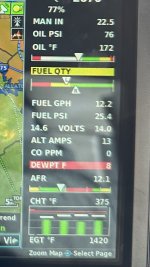I really did search but came up empty.
Here's what should be a basic leaning question. When departing my home field (KJSY) I'm at 5000' by the time I get to pattern altitude. Being such mountainous country, I'm frequently climbing to much higher altitudes. My conundrum is, how do I lean with a constantly increasing altitude? I mean, do you just lean until you're happy and just continue to lean to that value as you climb higher?? I really don't like the idea of waiting till I get to my destination altitude before starting to lean. This confused pilot would really like to know .
Here's what should be a basic leaning question. When departing my home field (KJSY) I'm at 5000' by the time I get to pattern altitude. Being such mountainous country, I'm frequently climbing to much higher altitudes. My conundrum is, how do I lean with a constantly increasing altitude? I mean, do you just lean until you're happy and just continue to lean to that value as you climb higher?? I really don't like the idea of waiting till I get to my destination altitude before starting to lean. This confused pilot would really like to know .






